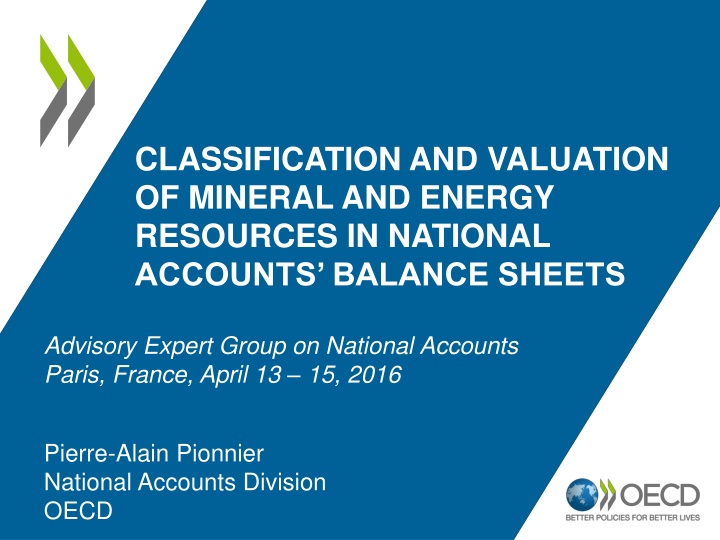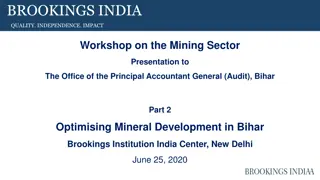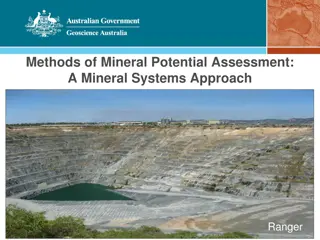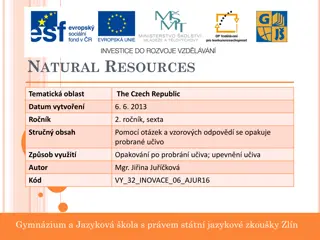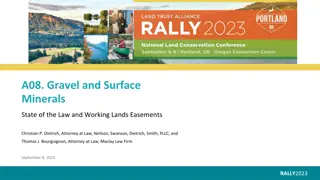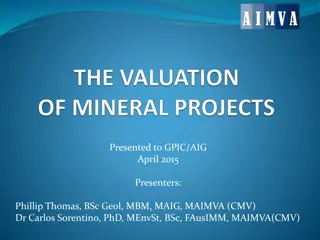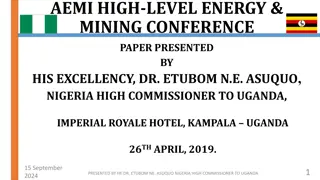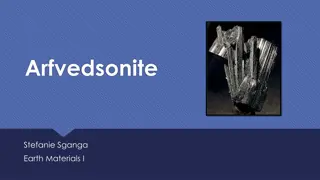Mineral and Energy Resources Classification and Valuation in National Accounts Balance Sheets
The presentation discusses the classification and valuation of mineral and energy resources in national accounts balance sheets, focusing on the alignment between the System of Environmental-Economic Accounting (SEEA) and the System of National Accounts (SNA) frameworks. It highlights the need for a clearer identification of these resources within the SNA, advocating for convergence with internationally agreed classification systems such as the United Nations Framework Classification (UNFC-2009) to ensure consistency and accuracy in economic assessments.
Download Presentation

Please find below an Image/Link to download the presentation.
The content on the website is provided AS IS for your information and personal use only. It may not be sold, licensed, or shared on other websites without obtaining consent from the author.If you encounter any issues during the download, it is possible that the publisher has removed the file from their server.
You are allowed to download the files provided on this website for personal or commercial use, subject to the condition that they are used lawfully. All files are the property of their respective owners.
The content on the website is provided AS IS for your information and personal use only. It may not be sold, licensed, or shared on other websites without obtaining consent from the author.
E N D
Presentation Transcript
CLASSIFICATION AND VALUATION OF MINERAL AND ENERGY RESOURCES IN NATIONAL ACCOUNTS BALANCE SHEETS Advisory Expert Group on National Accounts Paris, France, April 13 15, 2016 Pierre-Alain Pionnier National Accounts Division OECD
Introduction The SEEA 2012 was adopted as an international statistical standard by the UNSC in March 2012 SEEA provide a link between national accounts and environmental statistics SEEA wants to ensure, to the extent possible, consistency with the 2008 SNA Focus of this presentation on mineral and energy resources 2
Current treatment in the 2008 SNA Two conditions for defining economic assets (see 3.18 to 3.49): be owned by an institutional unit, and provide economic benefits to their owner. However, the 2008 SNA adds a specific criterion for mineral and energy resources (see 10.179): resources are economically exploitable given current technology and relative prices We argue that this treatment: is imprecise and prone to diverging interpretations by countries is not fully consistent with SEEA 2012 lacks economic justification 3
A clearer identification of mineral and energy resources in the 2008 SNA (1/5) Convergence between the main classification systems for mineral and energy resources is now well advanced Overarching classification relevant for all types of mineral and energy resources, which can be mapped with the main other classification systems: United Nations Framework Classification- 2009 (UNFC-2009) General principle of the UNFC-2009: classification follows three dimensions: socio-economic viability, project feasibility and geological knowledge. SEEA 2012 already makes reference to UNFC-2009, and defines three classes of resources, covering all known resources: Class A: Commercially recoverable resources Class B: Potentially commercially recoverable resources Class C: Non-commercial and other known deposits 4
A clearer identification of mineral and energy resources in the 2008 SNA (2/5) Contrary to the SEEA 2012, the 2008 SNA does not make reference to any internationally-agreed classification of mineral and energy resources As a consequence, the delineation of mineral and energy resources in the 2008 SNA is prone to diverging interpretations by countries See Australian and Canadian examples, for which we use the UNFC-2009 and the SEEA-2012 classes in order to identify which resources are covered in national accounts balance sheets 5
A clearer identification of mineral and energy resources in the 2008 SNA (3/5) Coverage of mineral and energy resources in the Australian balance sheets 6
A clearer identification of mineral and energy resources in the 2008 SNA (4/5) Coverage of mineral and energy resources in the Canadian balance sheets 7
A clearer identification of mineral and energy resources in the 2008 SNA (5/5) Recommendation #1: The 2008 SNA should explicitly refer to the SEEA 2012 and rely on the same three resource classes, based on the UNFC-2009, in order to delineate mineral and energy resources 8
Which resource classes to include in national accounts balance sheets? (1/3) Economic point of view: It makes perfect sense to attribute a non- zero value to deposits that are not economically viable under current resource prices, e.g. if price volatility is high enough to make future extraction profitable with a positive probability Practical point of view: Problems related to valuation of deposits that are currently non- profitable => not a reason to exclude them as a matter of principle Currently non-profitable deposits may have a significant value on the market => should be an incentive to improve valuation techniques. At a minimum, the same position could apply for these deposits as for goodwill and marketing assets in the 2008 SNA, i.e. provide the possibility to include them in the balance sheets as soon as reliable information on their value exists (e.g. evidence provided by sales/purchases of deposits) 9
Which resource classes to include in national accounts balance sheets? (2/3) The SEEA 2012 already allows to include all three classes of mineral and energy resources, i.e. all known resources, in the monetary asset accounts, contrary to the 2008 SNA The SEEA 2012 only recommends to keep separate accounts for these three classes: because valuation is more uncertain for Classes B and C because Classes B and C are not available for immediate extraction 10
Which resource classes to include in national accounts balance sheets? (3/3) Recommendation #2: The 2008 SNA should allow to include the three classes of mineral and energy resources in national accounts balance sheets when reliable information on their value exists, with the additional requirement (also found in the SEEA 2012) that separate accounts for the different classes are distinguished 11
Valuation of mineral and energy resources in balance sheets (1/5) Very limited guidance in the 2008 SNA, even for deposits that are profitable under current conditions Both the 2008 SNA and the SEEA 2012 recommend to rely on Net Present Value (NPV) computations SEEA 2012, chapter 5, provides more guidance on how monetary accounts relate to physical accounts, how to compute resource rents based on national accounts aggregates, and how to choose discount rates for the computation of NPVs 12
Valuation of mineral and energy resources in balance sheets (2/5) The OECD Task Force on SEEA Implementation recently worked on 4 additional issues: the valuation of currently non-profitable deposits the impact of ore-reserve and extraction cost heterogeneity on valuation calculations the distortions resulting from the constraints imposed on mineral production by associated capital the volatility in the value of mineral assets introduced by short-run price fluctuations 13
Valuation of mineral and energy resources in balance sheets (3/5) Heterogeneity of extraction costs across deposits: Identified as an important issue for valuation by the OECD Task Force As working at the mine (i.e. establishment) level is the best way to take this heterogeneity into consideration, the possibility to do so in practice is currently being explored with national statistical offices According to the mining engineering literature, output at the mine level remains broadly constant due to constraints imposed by initial investments in fixed capital, thus simplifying NPV computations 14
Valuation of mineral and energy resources in balance sheets (4/5) Volatility of commodity prices: In the financial literature, assets are commonly valued taking into account not only the expectation of future revenues, including their statistical distribution Could also be applied for the valuation of currently non-profitable deposits, thus eliminating the part of the volatility in balance sheets related to the switch of assets from currently non- profitable to currently profitable, and vice-versa Trying to implement such valuation techniques is not being considered as a priority, because it would require high quality data on how mining revenues, investments and extraction costs are determined at the micro level In the short run, using long-term averages of resource prices seems to be the easiest way forward to tackle the volatility issue 15
Valuation of mineral and energy resources in balance sheets (5/5) Recommendation #3: When it comes to the computation of net present values of mineral and energy deposits, the 2008 SNA should refer to the SEEA 2012, thereby underlining that the aim of the SNA (and the SEEA) is to compute market values, not social values, of mineral and energy deposits, and emphasising issues to which national accountants should pay particular attention: sensitivity of final results to the choice of the discount rate heterogeneity of extraction costs across deposits constraints imposed on mineral production at the micro level by initial investments in physical capital volatility in the value of mineral assets introduced by short-run price fluctuations of commodity prices 16
